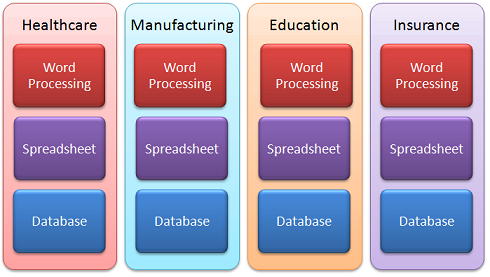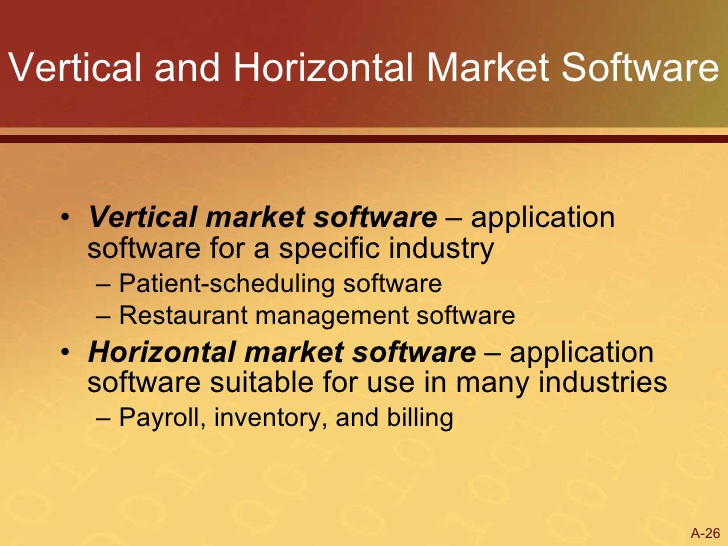Difference Between Horizontal and Vertical Market Software
Application software is composed of many diverse types of packages, each of which has its own specific task. Computers use application software to help you accomplish a specific task. Such software can be basically categorized into two major sub-categories: vertical market and horizontal market software. Vertical markets are industry-specific meaning they focus on one particular industry and are designed specifically to meet the needs of a particular marketing sector, such as financial, telecommunications or transportation. They may cater to a core group of clientele. This is very different from horizontal market software, which is designed to be used across a wide range of industries. Applications in the category of horizontal market segment are more flexible and can be applied more broadly, as opposed to vertical market software. Vertical market is industry-specific while horizontal market segments cut across industry boundaries. Today, majority of e-markets are vertically structured, but horizontal markets are also beginning to expand. Let’s take a look at some key differences between horizontal and vertical market software.

What is Vertical Market Software?
Vertical market software is industry-specific meaning the application software is specific to a particular market domain and thus addresses a limited group of clients and providers. It addresses the needs of a specific market domain or business. The software is developed for niche industry or applications, so they cater to a core group of clientele. A vertical market approach is intended to sell similar solutions that are developed and marketed using similar methods. They focus on one particular industry, such as financial, telecommunications or transportation. There are several examples of vertical market, such as banking, insurance, real estate, retail, manufacturing, transportation, and more. Banking software, which is used to manage customer accounts, cannot be used in a retail outlet or practically anywhere else because it is developed for that particular task.

What is Horizontal Market Software?
Horizontal market software, on the contrary, can serve a wide range of industries; in fact, they cut through all or many different market domains. Horizontal market segments often use a specific technology application to automate their daily business processes or functions. Unlike vertical market segments, they focus on broad categories that cross industry boundaries such as electricity, software or utilities. Applications in this category are more flexibly and can be applied broadly. For example, CRM software targets a broad range of applications to help businesses manage their relations with customers, and in that sense, uses a horizontal market approach. Even a word processor is horizontal market software which can be used in a cross-section of industries; it can be used to write reports in a bank or typing menus in a restaurant, or writing letters in insurance companies.
Difference between Horizontal and Vertical Market Software
Definition
– Vertical market software is industry-specific meaning the application software is specific to a particular market domain and thus addresses a limited group of clients and providers. The software is developed for niche industry or applications, so they cater to a core group of clientele. This can be contrasted with horizontal market software, which can be used in a cross-section of industries. Unlike vertical market segments, they focus on broad categories that cross industry boundaries such as electricity, software or utilities. Horizontal market software is general-purpose software and are more flexible and can be used across a broad range of industries or businesses.
Standardization
– Standardization is very difficult in horizontal market domains because some organizations provide services across different types of industries. So, if a service is relevant to almost everyone, the length of the wishlist tends to be excessive. The customers in a vertical market belong to one particular industry. However, standardization in vertical market sectors is equally difficult as it is in horizontal market, but for different reasons. Businesses in a vertical market focus on target specific needs and thus, they serve a limited group of companies. As such, they have their own set of business standards, as opposed to horizontal market.
Example
– Word processors and spreadsheets are some of the best examples of horizontal market software because they can be used across cross-section of industries. Other examples include CRM software which targets a broad range of applications to help businesses manage their relations with customers, and thus uses a horizontal market approach. There are several examples of vertical market, such as banking, insurance, real estate, retail, manufacturing, transportation, and more. Banking software, which can be used to manage customers’ transactions, cannot be used anywhere else.
Horizontal Market vs. Vertical Market Software: Comparison Chart

Summary
Vertical markets are industry-specific meaning they focus on one particular industry and are designed specifically to meet the needs of a particular marketing sector, such as financial, telecommunications or transportation. Horizontal market domains, on the contrary, cut through all or many different market domains and focus on broad categories that cross industry boundaries. A vertical market approach is intended to sell similar solutions that are developed and marketed using similar methods while horizontal markets use a specific technology application to automate their daily business processes or functions.
- Difference Between Caucus and Primary - June 18, 2024
- Difference Between PPO and POS - May 30, 2024
- Difference Between RFID and NFC - May 28, 2024
Search DifferenceBetween.net :
Leave a Response
References :
[0]Bidgoli, Hossein. The Internet Encyclopedia, Volume 1. Hoboken, New Jersey: John Wiley & Sons, 2004. Print
[1]Mohr, Jakki J., et al. Marketing of High-technology Products and Innovations. New Jersey, United States: Prentice Hall, 2010. Print
[2]O'Connor, Peter. Using Computers in Hospitality. Boston, Massachusetts: Cengage, 2004. Print
[3]Szyperski, Clemens. Component Software: Beyond Object-Oriented Programming (2nd edition). New Delhi, India: Pearson Education India, 2003. Print
[4]Image credit: https://image.slidesharecdn.com/introtohardwareandsoftware-090830202558-phpapp02/95/intro-to-hardware-and-software-26-728.jpg?cb=1251754106
[5]Image credit: http://blog.gust.com/wp-content/uploads/2013/12/verticalmarkets.png
